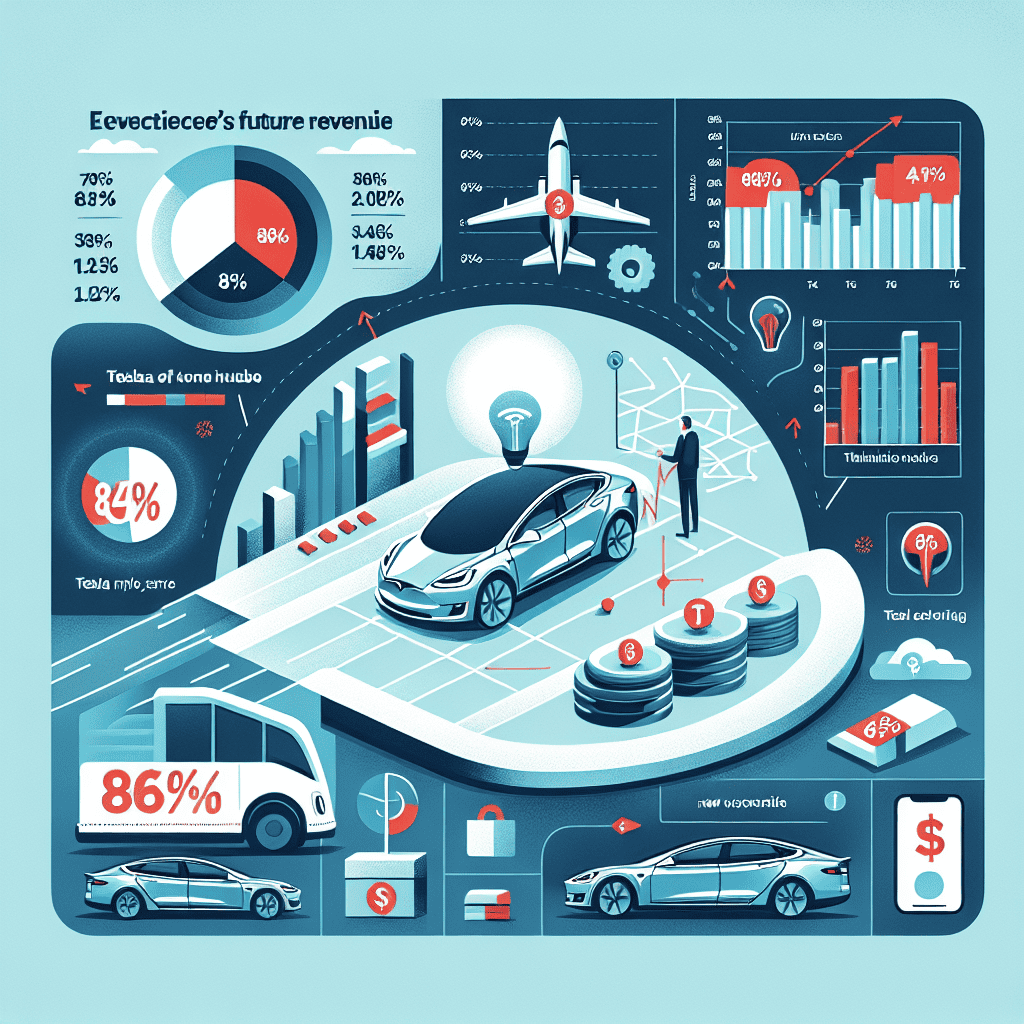“Tesla’s Future: Powering Profits Beyond the Road.”
Introduction
Tesla’s future earnings landscape is poised for a significant transformation, with projections indicating that a substantial 86% of its revenue may soon originate from a source other than electric vehicle (EV) sales. As the company continues to innovate and expand its technological and energy solutions, this shift underscores Tesla’s strategic diversification beyond its core automotive business. The anticipated change highlights the growing importance of alternative revenue streams, such as energy storage solutions, software services, and autonomous driving technology, which are expected to play a pivotal role in shaping Tesla’s financial future. This evolution not only reflects Tesla’s adaptability in a rapidly changing market but also its commitment to leveraging its technological prowess to capture new opportunities and drive sustained growth.
Diversification into Energy Solutions
Tesla, a company synonymous with electric vehicles (EVs), is on the brink of a significant transformation that could redefine its revenue streams. While the automotive sector has been the cornerstone of Tesla’s financial success, the company is increasingly setting its sights on energy solutions as a pivotal component of its future earnings. This strategic pivot is not merely a diversification effort but a calculated move to capitalize on the burgeoning demand for sustainable energy solutions. As the global energy landscape undergoes a seismic shift towards renewable sources, Tesla’s foray into energy solutions could soon account for a staggering 86% of its earnings, overshadowing its traditional EV sales.
The rationale behind this strategic shift is multifaceted. Firstly, the global push towards decarbonization has accelerated the adoption of renewable energy technologies. Governments worldwide are implementing stringent regulations to curb carbon emissions, thereby creating a fertile ground for companies like Tesla to expand their energy solutions portfolio. Tesla’s energy division, which includes products like solar panels, solar roofs, and energy storage solutions such as the Powerwall and Powerpack, is well-positioned to tap into this growing market. These products not only complement Tesla’s mission of accelerating the world’s transition to sustainable energy but also offer substantial growth potential.
Moreover, Tesla’s energy solutions are not limited to residential applications. The company is actively pursuing large-scale energy projects that cater to commercial and industrial clients. By providing integrated energy solutions that combine solar power generation with advanced energy storage systems, Tesla is addressing the critical need for reliable and sustainable energy sources. This approach not only enhances energy security but also offers cost savings for businesses, making it an attractive proposition for a wide range of industries.
In addition to the favorable market conditions, Tesla’s technological prowess gives it a competitive edge in the energy sector. The company’s expertise in battery technology, honed through years of developing EVs, is a significant asset in the energy storage market. Tesla’s batteries are renowned for their efficiency, durability, and scalability, making them ideal for both small-scale and large-scale applications. Furthermore, Tesla’s commitment to innovation ensures that its energy solutions remain at the forefront of technological advancements, thereby maintaining a competitive advantage in a rapidly evolving industry.
Another factor contributing to Tesla’s potential earnings shift is the increasing consumer awareness and demand for sustainable energy solutions. As individuals and businesses become more conscious of their environmental impact, the demand for clean energy alternatives is expected to rise exponentially. Tesla’s brand reputation as a pioneer in sustainability positions it favorably to capture a significant share of this market. By leveraging its strong brand identity and customer loyalty, Tesla can effectively promote its energy solutions and drive adoption across various segments.
In conclusion, Tesla’s strategic focus on energy solutions represents a transformative shift that could redefine its earnings landscape. By capitalizing on the global transition towards renewable energy, leveraging its technological expertise, and tapping into growing consumer demand, Tesla is poised to derive a substantial portion of its future earnings from its energy division. This diversification not only aligns with Tesla’s overarching mission but also positions the company for sustained growth in an increasingly competitive and dynamic market. As Tesla continues to innovate and expand its energy solutions portfolio, the potential for this sector to eclipse its traditional EV sales becomes increasingly plausible, heralding a new era for the company.
Expansion of Autonomous Driving Technology
Tesla, a company synonymous with electric vehicles (EVs), is on the cusp of a transformative shift that could redefine its revenue streams. While the company has long been celebrated for its pioneering role in the EV market, recent developments suggest that its future earnings may increasingly derive from a different source: autonomous driving technology. This shift is not merely speculative; it is grounded in Tesla’s strategic investments and technological advancements that position it at the forefront of the autonomous driving revolution.
To understand this potential shift, it is essential to consider the broader context of the automotive industry. The global push towards sustainability has accelerated the adoption of electric vehicles, with Tesla leading the charge. However, as the market becomes more saturated and competition intensifies, Tesla is looking to diversify its revenue streams. Autonomous driving technology presents a lucrative opportunity, promising not only to enhance the functionality of Tesla’s vehicles but also to open new avenues for revenue generation.
Tesla’s commitment to autonomous driving is evident in its substantial investments in research and development. The company has been developing its Full Self-Driving (FSD) software, which aims to enable vehicles to navigate roads with minimal human intervention. This technology, still in its nascent stages, has the potential to revolutionize transportation by reducing accidents, improving traffic flow, and offering new mobility solutions. As Tesla continues to refine its FSD software, it is poised to capture a significant share of the autonomous vehicle market.
Moreover, Tesla’s approach to autonomous driving is distinct from its competitors. While many companies rely on lidar technology, Tesla has opted for a vision-based system, leveraging cameras and artificial intelligence to interpret the driving environment. This approach not only reduces costs but also aligns with Tesla’s philosophy of integrating cutting-edge technology into its vehicles. As the FSD software matures, it could become a major revenue driver, with Tesla offering it as a subscription service or a one-time purchase, thereby creating a steady stream of income.
In addition to direct sales of autonomous driving software, Tesla’s technology could facilitate the development of new business models. For instance, the advent of autonomous ride-hailing services could transform urban transportation, offering a convenient and cost-effective alternative to traditional taxis and ride-sharing platforms. Tesla’s vehicles, equipped with advanced autonomous capabilities, could serve as the backbone of such services, generating substantial revenue through ride fees and service subscriptions.
Furthermore, the data generated by Tesla’s autonomous vehicles could become a valuable asset. As these vehicles navigate roads, they collect vast amounts of data on driving patterns, road conditions, and traffic dynamics. This data, when anonymized and aggregated, could be sold to urban planners, insurance companies, and other stakeholders interested in optimizing transportation systems and enhancing road safety.
In conclusion, while Tesla’s electric vehicles have been the cornerstone of its success, the company’s future earnings may increasingly derive from its autonomous driving technology. By capitalizing on its technological prowess and strategic vision, Tesla is well-positioned to lead the autonomous driving revolution. As this technology becomes more prevalent, it could account for a significant portion of Tesla’s revenue, potentially surpassing traditional EV sales. This shift not only underscores Tesla’s innovative spirit but also highlights the transformative potential of autonomous driving technology in reshaping the future of transportation.
Growth in Battery Production and Storage
Tesla, a company synonymous with electric vehicles (EVs), is on the cusp of a significant transformation that could redefine its revenue streams. While the company has long been celebrated for its pioneering role in the EV market, recent developments suggest that its future earnings may increasingly derive from a different source: battery production and storage. This shift is not only indicative of Tesla’s strategic foresight but also highlights the growing importance of energy storage solutions in the global transition to sustainable energy.
The burgeoning demand for renewable energy has underscored the critical need for efficient energy storage systems. As solar and wind power become more prevalent, the ability to store energy for use during periods of low generation is paramount. Tesla, recognizing this opportunity, has been investing heavily in its battery technology and production capabilities. The company’s Gigafactories, which are strategically located around the world, are at the heart of this initiative. These facilities are designed to produce batteries at scale, thereby reducing costs and increasing accessibility.
Moreover, Tesla’s advancements in battery technology have positioned it as a leader in the energy storage sector. The company’s Powerwall and Powerpack products, which are designed for residential and commercial use respectively, have gained significant traction. These products not only provide backup power but also enable users to optimize their energy consumption, thereby reducing reliance on traditional power grids. As more consumers and businesses seek to reduce their carbon footprint, the demand for such solutions is expected to rise exponentially.
In addition to residential and commercial applications, Tesla’s battery technology is also being deployed in large-scale energy projects. The company’s involvement in projects like the Hornsdale Power Reserve in South Australia, which is one of the largest lithium-ion battery installations in the world, underscores its capability to deliver robust energy storage solutions. These projects not only enhance grid stability but also demonstrate the potential for batteries to play a pivotal role in the energy landscape.
Furthermore, Tesla’s strategic partnerships and collaborations are likely to bolster its position in the battery production and storage market. By aligning with other industry leaders and governments, Tesla is poised to expand its reach and influence. These collaborations are expected to facilitate the development of new technologies and the establishment of additional production facilities, thereby accelerating the adoption of battery storage solutions globally.
As Tesla continues to innovate and expand its battery production capabilities, the financial implications are significant. Analysts predict that as much as 86% of Tesla’s future earnings could derive from its battery production and storage business, overshadowing its traditional EV sales. This potential shift in revenue streams reflects the growing importance of energy storage in the context of global sustainability goals.
In conclusion, Tesla’s focus on battery production and storage represents a strategic pivot that aligns with the broader trends in the energy sector. As the world moves towards a more sustainable future, the demand for efficient and scalable energy storage solutions is set to increase. Tesla, with its advanced technology and strategic initiatives, is well-positioned to capitalize on this opportunity. Consequently, the company’s future earnings may increasingly be driven by its contributions to the energy storage market, marking a new chapter in its evolution.
Development of Solar Energy Products

Tesla, a company synonymous with electric vehicles (EVs), is on the cusp of a significant transformation that could redefine its revenue streams. While the automotive sector has been the cornerstone of Tesla’s financial success, the company is increasingly turning its attention to the development of solar energy products. This strategic pivot is not merely a diversification effort but a calculated move to capitalize on the burgeoning demand for renewable energy solutions. As a result, industry analysts predict that up to 86% of Tesla’s future earnings could soon derive from its solar energy ventures rather than EV sales.
The rationale behind this shift is multifaceted. Firstly, the global push towards sustainable energy has never been more pronounced. Governments worldwide are implementing stringent regulations to curb carbon emissions, and consumers are becoming more environmentally conscious. This trend has created a fertile ground for solar energy products, which offer a clean and sustainable alternative to traditional energy sources. Tesla, with its innovative prowess and brand recognition, is well-positioned to capture a significant share of this expanding market.
Moreover, Tesla’s foray into solar energy is not a recent development. The company has been investing in solar technology for years, most notably through its acquisition of SolarCity in 2016. This acquisition laid the groundwork for Tesla’s solar division, which has since developed a range of products, including solar panels and the Solar Roof. These products are designed to seamlessly integrate with Tesla’s energy storage solutions, such as the Powerwall, creating a comprehensive ecosystem for energy generation and consumption.
In addition to product development, Tesla is also focusing on enhancing the efficiency and affordability of its solar offerings. The company is leveraging its expertise in manufacturing and supply chain management to drive down costs, making solar energy more accessible to a broader audience. This approach aligns with Tesla’s overarching mission to accelerate the world’s transition to sustainable energy, a vision that extends beyond the automotive industry.
Furthermore, Tesla’s solar energy products are gaining traction in both residential and commercial markets. Homeowners are increasingly adopting solar solutions to reduce their reliance on grid electricity and lower their energy bills. Simultaneously, businesses are recognizing the long-term financial and environmental benefits of solar energy, leading to increased adoption in commercial settings. This dual-market strategy not only diversifies Tesla’s customer base but also mitigates risks associated with fluctuations in the automotive sector.
As Tesla continues to innovate and expand its solar energy portfolio, the potential for substantial revenue growth becomes increasingly apparent. The company’s ability to integrate its solar products with its existing EV and energy storage offerings creates a unique value proposition that competitors may find challenging to replicate. This synergy not only enhances customer loyalty but also positions Tesla as a leader in the renewable energy landscape.
In conclusion, while Tesla’s electric vehicles have undoubtedly revolutionized the automotive industry, the company’s future earnings may soon be dominated by its solar energy products. By capitalizing on the growing demand for sustainable energy solutions and leveraging its technological expertise, Tesla is poised to become a major player in the solar market. As the world continues to embrace renewable energy, Tesla’s strategic shift towards solar products could prove to be a pivotal moment in the company’s evolution, potentially reshaping its financial landscape for years to come.
Advancements in AI and Robotics
Tesla, a company synonymous with electric vehicles (EVs), is on the brink of a transformative shift that could redefine its revenue streams. While the world has come to associate Tesla primarily with its innovative EVs, the company’s future earnings may soon be dominated by advancements in artificial intelligence (AI) and robotics. This potential shift is not merely speculative; it is rooted in Tesla’s strategic investments and developments in these cutting-edge technologies.
To understand this transition, it is essential to consider Tesla’s ongoing efforts in AI and robotics. The company has been at the forefront of integrating AI into its vehicles, particularly through its Autopilot and Full Self-Driving (FSD) technologies. These systems leverage advanced machine learning algorithms to enable semi-autonomous and, eventually, fully autonomous driving capabilities. As these technologies mature, they promise to revolutionize transportation by enhancing safety, efficiency, and convenience. However, the implications of Tesla’s AI advancements extend far beyond the automotive sector.
Tesla’s foray into robotics is exemplified by its development of the Tesla Bot, a humanoid robot designed to perform tasks that are repetitive, dangerous, or otherwise undesirable for humans. This ambitious project underscores Tesla’s commitment to leveraging its AI expertise to create versatile robotic solutions. The potential applications for such robots are vast, ranging from industrial automation to personal assistance, and they could significantly impact various sectors of the economy.
Moreover, Tesla’s AI and robotics initiatives are supported by its robust data infrastructure. The company collects vast amounts of data from its fleet of vehicles, which is then used to train and refine its AI models. This data-driven approach not only enhances the performance of Tesla’s autonomous systems but also provides a competitive edge in the broader AI and robotics landscape. As Tesla continues to amass and analyze data, its AI capabilities are likely to become increasingly sophisticated, further solidifying its position as a leader in this domain.
In addition to technological advancements, Tesla’s strategic vision plays a crucial role in this potential revenue shift. CEO Elon Musk has consistently emphasized the importance of AI and robotics in Tesla’s long-term strategy. By investing heavily in these areas, Tesla aims to diversify its revenue streams and reduce its reliance on vehicle sales. This strategic pivot is particularly significant given the growing competition in the EV market, where traditional automakers and new entrants alike are vying for market share.
Furthermore, the economic potential of AI and robotics is immense. According to industry analysts, the global AI market is projected to reach trillions of dollars in the coming years, driven by demand for automation and intelligent solutions across various sectors. Similarly, the robotics market is expected to experience substantial growth as industries increasingly adopt robotic technologies to enhance productivity and address labor shortages. By positioning itself at the intersection of these burgeoning markets, Tesla stands to capture a significant share of the economic opportunities they present.
In conclusion, while Tesla’s electric vehicles have been the cornerstone of its success, the company’s future earnings may increasingly derive from its advancements in AI and robotics. Through strategic investments and a commitment to innovation, Tesla is poised to capitalize on the transformative potential of these technologies. As the company continues to push the boundaries of what is possible, it may soon find that the majority of its revenue comes not from selling cars, but from leading the charge in AI and robotics.
Strategic Partnerships and Collaborations
Tesla, a company synonymous with electric vehicles (EVs), has long been at the forefront of the automotive industry’s shift towards sustainable energy. However, as the company continues to evolve, its future earnings may increasingly derive from a source other than EV sales. Strategic partnerships and collaborations are poised to play a pivotal role in this transformation, potentially accounting for as much as 86% of Tesla’s future revenue streams. This shift underscores the importance of diversification in Tesla’s business model, as it seeks to leverage its technological prowess and innovative spirit beyond the realm of electric vehicles.
To begin with, Tesla’s foray into energy solutions has been marked by significant strides in battery technology and energy storage systems. The company’s collaboration with various energy providers and governments worldwide has facilitated the deployment of large-scale battery projects, such as the Hornsdale Power Reserve in South Australia. These projects not only demonstrate Tesla’s capability in stabilizing power grids but also highlight the potential for substantial revenue generation from energy storage solutions. As the global demand for renewable energy sources continues to rise, Tesla’s strategic partnerships in this sector are likely to become increasingly lucrative.
Moreover, Tesla’s expertise in autonomous driving technology presents another avenue for strategic collaborations. The company’s Autopilot and Full Self-Driving (FSD) systems have garnered significant attention, and partnerships with other automotive manufacturers could accelerate the adoption of these technologies. By licensing its autonomous driving software to other carmakers, Tesla can tap into a vast market, thereby diversifying its revenue streams. This approach not only enhances Tesla’s position as a leader in autonomous technology but also fosters a collaborative ecosystem that benefits the entire automotive industry.
In addition to energy solutions and autonomous driving, Tesla’s ventures into artificial intelligence (AI) and robotics further exemplify its commitment to strategic partnerships. The development of the Tesla Bot, a humanoid robot designed to perform repetitive and mundane tasks, showcases the company’s ambition to revolutionize industries beyond automotive. Collaborations with technology firms and research institutions could expedite the refinement and deployment of such innovations, opening up new revenue channels. As AI and robotics continue to permeate various sectors, Tesla’s strategic alliances in these fields could significantly bolster its earnings potential.
Furthermore, Tesla’s involvement in the development of charging infrastructure is another critical aspect of its strategic partnerships. By collaborating with governments and private entities to expand its Supercharger network, Tesla not only enhances the convenience of EV ownership but also creates opportunities for recurring revenue through charging services. As the adoption of electric vehicles accelerates globally, the demand for robust charging infrastructure will inevitably rise, positioning Tesla to capitalize on this growing market.
In conclusion, while Tesla’s electric vehicles have been the cornerstone of its success, the company’s future earnings are likely to be increasingly driven by strategic partnerships and collaborations. By diversifying its business model and leveraging its technological expertise, Tesla is well-positioned to tap into new revenue streams in energy solutions, autonomous driving, AI, robotics, and charging infrastructure. As these partnerships mature and expand, they have the potential to transform Tesla’s financial landscape, underscoring the importance of collaboration in the company’s ongoing evolution. Through these strategic endeavors, Tesla is not only redefining its own future but also shaping the trajectory of multiple industries on a global scale.
Innovations in Transportation Infrastructure
Tesla, a name synonymous with electric vehicles (EVs), has long been at the forefront of the automotive industry’s shift towards sustainable energy. However, as the company continues to innovate and expand its horizons, it is becoming increasingly apparent that its future earnings may not solely rely on EV sales. Instead, a significant portion, potentially up to 86%, could soon derive from a different source: transportation infrastructure innovations. This shift is indicative of Tesla’s strategic pivot towards becoming a comprehensive energy and technology company, rather than just an automaker.
One of the primary areas where Tesla is poised to make substantial gains is in the development and deployment of autonomous driving technology. The company’s Full Self-Driving (FSD) software, which is continually being refined and improved, represents a significant leap forward in transportation infrastructure. As this technology matures, it is expected to revolutionize the way people and goods are transported, leading to new revenue streams for Tesla. The potential for autonomous vehicles to operate as part of a ride-sharing network or logistics fleet could generate substantial income, far surpassing traditional vehicle sales.
Moreover, Tesla’s advancements in battery technology and energy storage solutions are set to play a crucial role in its future earnings. The company’s energy division, which includes products like the Powerwall, Powerpack, and Megapack, is designed to store and distribute renewable energy efficiently. As the world increasingly shifts towards sustainable energy sources, the demand for reliable energy storage solutions is expected to surge. Tesla’s expertise in this area positions it well to capitalize on this growing market, providing another significant source of revenue.
In addition to these technological advancements, Tesla’s foray into the development of charging infrastructure is another critical component of its future earnings strategy. The expansion of the Supercharger network, which provides fast and convenient charging options for EV owners, not only supports Tesla’s vehicle sales but also opens up opportunities for monetization through partnerships and collaborations with other automakers. As the adoption of electric vehicles continues to rise globally, the demand for robust charging infrastructure will become increasingly important, further enhancing Tesla’s revenue potential.
Furthermore, Tesla’s commitment to innovation extends beyond its products to its manufacturing processes. The company’s Gigafactories, which are designed to produce batteries and vehicles at scale, are a testament to its focus on efficiency and sustainability. By optimizing production capabilities and reducing costs, Tesla can maintain competitive pricing while maximizing profitability. This approach not only supports its core business but also enables the company to invest in new technologies and infrastructure projects that will drive future growth.
In conclusion, while Tesla’s electric vehicles have been the cornerstone of its success, the company’s future earnings are likely to be driven by a diverse range of innovations in transportation infrastructure. From autonomous driving technology and energy storage solutions to charging networks and advanced manufacturing processes, Tesla is positioning itself to be a leader in the broader energy and technology sectors. As these initiatives come to fruition, they have the potential to transform the company’s revenue model, with up to 86% of earnings deriving from sources beyond traditional EV sales. This strategic shift underscores Tesla’s vision of a sustainable future and its commitment to pioneering advancements that will shape the transportation landscape for years to come.
Q&A
1. **What is the new source of revenue for Tesla?**
Tesla’s future earnings may increasingly derive from software and services, particularly autonomous driving technology and energy solutions, rather than just electric vehicle (EV) sales.
2. **Why is Tesla focusing on software and services?**
Software and services offer higher profit margins compared to vehicle sales, and Tesla aims to capitalize on its advancements in autonomous driving and energy products.
3. **How much of Tesla’s future earnings could come from this new source?**
It is projected that up to 86% of Tesla’s future earnings could come from software and services, including autonomous driving subscriptions and energy solutions.
4. **What role does autonomous driving play in Tesla’s strategy?**
Autonomous driving is a key component, with Tesla developing Full Self-Driving (FSD) technology that could be offered as a subscription service, generating recurring revenue.
5. **How does Tesla’s energy business contribute to future earnings?**
Tesla’s energy business, including solar products and energy storage solutions like the Powerwall and Megapack, is expected to grow and contribute significantly to earnings.
6. **What are the potential benefits of this shift in revenue sources for Tesla?**
The shift to software and services could lead to more stable and predictable revenue streams, higher profit margins, and reduced dependency on vehicle sales.
7. **What challenges might Tesla face in this transition?**
Tesla may face challenges such as regulatory hurdles for autonomous driving, competition in the software and energy sectors, and the need to continuously innovate to maintain its market position.
Conclusion
Tesla’s future earnings are projected to increasingly rely on energy generation and storage solutions, potentially accounting for 86% of its revenue. This shift is driven by the growing demand for sustainable energy solutions, advancements in battery technology, and Tesla’s strategic investments in solar energy and energy storage systems. As the global focus on renewable energy intensifies, Tesla’s diversification beyond electric vehicle sales positions the company to capitalize on emerging opportunities in the energy sector, potentially leading to significant revenue growth and a more balanced business model.





